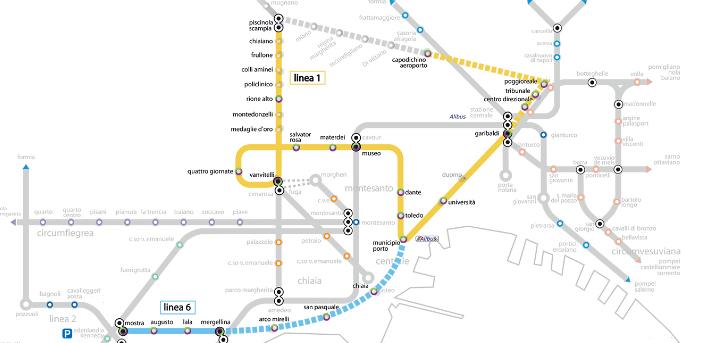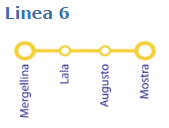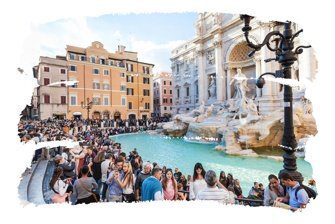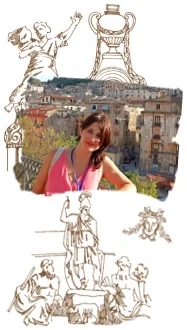How does the subway in Naples work?
Those who want to get to know Naples quickly, efficiently and affordably can consider using the subway , which connects different points of the city. Today we are going to learn everything about the Naples subway. Let’s go to our post of the day! How does the subway in Naples work? Here at Your Travel to Italy with Ana Patricia you make the trip of your dreams !!! ALSO: see our “Accommodation in Italy – Tips for your holidays!”
Vídeo about Naples
(Source: Nicola Capuozzo Free Wings Naples)
Introduction
Naples , in Campania, in southern Italy, is one of the most visited cities on the Italian peninsula. With excellent connections both regionally and inter-regionally, the city offers great public transport options for its visitors, such as trains, buses and subways. Today we are going to talk about a quick and cheap option, the Naples metro. Discover here some round trips from Naples!
Discover the Subway Lines in Naples
The city’s metro consists of two lines integrated into a broader network of rail services. It has LINE 1 and LINE 6. What do you mean?And from 2 to 5 , Ana Patrícia? That’s right: lines 2 to 5 are not managed by Metropolitana di Napoli. Let’s understand …
LINE 1 , inaugurated in 1993, is interconnected with three municipal funiculars (Chiaia, Centrale and Montesanto) and has several interchanges with LINE 2, which is managed by Trenitalia, with the Circumvesuviana network and with the Arcobaleno line, headed by regional holding Ente Autonomous Volturno (EAV). LINE 6 was inaugurated in 2007 and is managed by the ANM. It is a light metro that runs between Mergellina, close to the station. This line has only 4 stations: Mostra, Augusto, Lala and Mergellina, but it is still undergoing extension works; they will interconnect LINE 6 with LINE 1 and add 4 more stops. There is no forecast for the completion of the works. Find here some Itineraries in Naples for one and two days …
Good to know …
- In LINE 1, ALL stations are part of the art station circuit, which brings together 15 stations in total. They are beautiful stations and, by themselves, are worth the subway ride. We’ll see a little more about this later.
- Of course, at peak times – between 7:30 am and 9:30 am and between 5:00 pm and 7:00 pm – you can find the subway a little crowded, after all it is a very used means of transport, also , by local residents to go to and from work, for I suggest you avoid these hours. Visit our sections: Traveling by Train and Traveling by Car.
Opening hours and values
Pay attention to the hours of operation of the metro lines in Naples, which are constantly changing their schedules.
- The hours of LINE 1 are divided into three main bands : during the week it opens at 06:20 am and closes at 11:02 pm; in Piscinola, the station opens at 06:00 am and closes at 10:22 pm. On holidays, Piscinola is also open from 06:00 am to 10:22 pm, however, from Garibaldi, the first train leaves at 06:20 am and the last at 11:03 pm. On weekends, the schedule is extended: from Piscinola the last train leaves at 12:48 am and from Garibaldi at 01:32 am.
- LINE 6 is open every day, from 06:20 am to 11:02 pm.
- For all information about possible changes in hours and / or prices, visit the Metropolitana di Napoli’s official website.
- The ticket costs 1.10 euros and the daily ticket 3.50 euros.
Curiosities:
- The subway in Naples is the third largest in Italy, second only to Milan and Rome. Learn about Rome Subway! Learn more about the Milan subway!
Map of Naples Subway Lines 1 and 6

LINE 1
Line 1 connects the northern terminal of Piscinola / Scampia with the Garibaldi station, which integrates the metro with the railway lines and the stations where high-speed trains arrive and depart; it passes through the mountainous area of Vomero and the old city center.
During the week, trains run from 6:00 am to 11:00 pm and train breaks can reach 10 minutes at peak times. It is 18 km long and the stations that make up the line are: Garibaldi, Università, Municipio, Toledo, Dante, Museo, Materdei, Salvator Rosa, Quattro Giornate, Vanvitelli, Medaglie d’Oro, Montedonzelli, Rione Alto, Policlinico, Colli Aminei, Frullone, Chiaiano, Piscinola. Most of the stretches are underground, with the exception of the stretch between Colli Aminei / Piscinola, which runs through a viaduct. All stations offer excellent accessibility for wheelchair users.
Golden Tip
- To visit the historic center of the city, get off at one of these stations: Montesanto or Piazza Cavour – you can easily walk.
Naples Subway Line 1 Map

LINE 6
Line 6 connects the Fuorigrotta district with Mergellina. The stretch has only 4 stations: Mostra, Augusto, Lala and Mergellina, and has a length of 2.3 km. Still under construction, line 6 will reach Piazza Municipio, and will connect to line 1. The stations currently under construction are Arco Mirelli, San Pasquale and Chiaia. Once the works are completed, the total route will have 5.5 km and 8 stations. Line 6 also interconnects with the Cumana railway at the Tecchio stop, while in Mergellina it is directly connected to the Line 2 metro (Trenitalia).
Naples Subway Line 6 Map

The art present in the metro stations of Naples
Naples’ art stations are an artistic-functional complex and are made up of fifteen stations : eleven from line 1 and four from line 6. The main objective of this project, conceived in 1995, is to combine art in people’s daily lives, and the stations are also used to promote new artists.
The eleven stations of Line 1
The art stations feature around 200 works of art signed by more than 90 artists. The project received several international awards and, in 2012 and 2014, Toledo station was voted the most beautiful metro station in Europe by The Daily Telegraph and CNN, respectively. Below is a brief summary of the art stations of the subway in Naples, line 1:
Garibaldi Station
Designed by French architect Dominique Perrault, it features a large Teflon-perforated metal pergola on the outside. Inside, which is dominated by steel, it looks like a large room lit by natural light and crossed by overhead escalators. The works present there are by Michelangelo Pistoletto. These are mirrored steel panels with full-size silkscreen prints of photos of passengers waiting for the train. The station was inspired by the London Underground.
University Station
This stop was designed by architects Karim Rashid and Alessandro Mendini and is the most eclectic of all. It’s super colorful and was designed to symbolize the digital world, so much so that, climbing the access stairs, you find yourself surrounded by terms from the 70s, such as “network”, “database”, “software”, among others words, printed on ceramic tiles.
Passing through the turnstiles, three works of contemporary art are beautifully presented:
- Ikon Lenticular, which is an LED backlit light box, where we can see virtual three-dimensional figures on a white background;
- We also have the work Synapsi, which is an all-metal sculpture that represents the synapses, cells of our nervous tissue responsible for communication; it’s the
- Conversational Profile, which consists of four cylindrical pillars covered in black Corian, where in the two central pillars it is possible to recognize two human profiles that communicate with each other. From the ceiling, up to the escalators, you can see the light from the translucent paneled false ceiling in blue and pink. On the middle floor, on the steps of the fixed staircase, there are portraits of Dante – going to Piscinola – and Beatrice – going to Garibaldi: both are a tribute to humanistic culture and technological knowledge.
Town Hall Station
The project for this station is by Portuguese architects Álvaro Siza and Eduardo Souto de Moura. It went through 27 changes during its execution due to several archaeological finds in the area during the excavations. Today, the station is elegant and beautiful and, inside, there is a single art installation: a video-fresco called “Passages”, by Michal Rovner. The video features images that are sent by five large projectors and are mixed with the artists’ watercolors.
Toledo Station
The most celebrated metro station in Naples.It is an incredibly beautiful station and one of the most famous in the world. As already mentioned, it was awarded several times, and not for nothing! The person responsible for this project is the Spanish designer Óscar Tusquets Blanca. The communication between its exterior and its interior is due to the lighting coming from the skylight systems, which direct sunlight, ‘playing’ with the architecture of the place.
On the first floor, the modern meets the old and we can admire the impeccable integration of the remains of the walls from the Aragonese period. The predominant color is black, which stands out splendidly with the mosaics by William Kentridge. On the second floor the color turns to an illuminated yellow that was based on the Neapolitan tuff and from there we reach the ‘zero’ level, at sea level which, of course, presents us with incredible blue mosaics that gain intensity as we go forward .
When we finally reach the underground, we see the oval mouth of Robert Wilson’s work:
A large cone that passes through all levels of the station. There, on the walls, we can see the Olas, which are relief waves designed by Oscar Tusquets Blanca. The panels inspired by the sea, by Robert Wilson, and named “By the sea … you and me”, enchant us: they are LED light boxes made with a lenticular technique that gives us the sensation of, in fact, being surrounded by water . At the other exit of the station, at Largo Montecalvario, which was also designed by Oscar Tusquets, we can see the work entitled Razza Umana, by Oliviero Toscani, which are two long light boxes that show us a photograph of human morphology that also look like be at the bottom of the sea.
Dante station
Designed by the splendid Gae Aulenti, it presents itself in a charming and modern way. The entrances to the station were made of steel and glass and, in the atrium of the station, two paintings by Carlo Alfano, a Neapolitan painter and sculptor, were placed. On the staircase that takes us to the floor below, there is a work by Joseph Kosuth that was inspired by an excerpt from ‘Convivio’, by Dante Alighieri. On the wall, we can see the work “Without Title”, by Jannis Kounellis, which presents lines that remind us of rails and house various objects, such as men’s and women’s shoes, toy train locomotives, an overcoat and a hat. Another work of the station is “Universe without bombs, kingdom of flowers. 7 red angels ”, by Nicola De Maria: is a beautiful combination of oval and red geometric shapes!
Station Museum
The Museo station is a project by the brilliant Gae Aulenti and is connected to the Piazza Cavour station. Its façade was inspired by a building in red plaster from Pompeii and stone from Vesuvius, a reminder of the nearby National Archaeological Museum. The station has three 3 entrances and all have fantastic artwork! In the main entrance hall, you will be greeted by a statue of Farnese Hercules, made in fiberglass by the Naples Academy of Fine Arts; the secondary entrance has a bronze work of the monumental horse’s head called “Carafa”, and the upper entrance has a bronze reproduction of Laocoon, made by the Chiurazzi Historical Foundry.
In the interior corridors, we can also see beautiful works:
In the corridor that leads towards the Archaeological Museum, we find several black and white photographs of athletes and dancers, taken by Mimmo Jodice. In the link with the Archaeological Museum, there is also the “Neapolis Station”, a small educational exhibition that presents some archaeological finds found during the excavation work at the station itself. In another corridor, the one that connects the Museo station to the Cavour station (Line 2), we find the works of 4 photographers from Campania: Luciano D’Alessandro, Fabio Donato, Antonio Biasucci and Raffaela Mariniello.
Martedei Station
It was designed by architect Alessandro Mendini and opened to the public in 2003. The inauguration of this station revitalized Piazza Scipione Ammirato, transforming it into a beautiful pedestrian zone with delightful green spaces, urban furniture and works of art.
Among them, the following deserve to be highlighted:
Carpe Diem, sculpture in colored bronze by Luigi Serafini; the ceramic reliefs that cover the external elevator and the beautiful entrance covered by mosaics, with a large green and yellow star. The square has a beautiful steel tower and colored glass, which let natural light invade the station and also shows us a mosaic by Sandro Chia with marine figures. The flight of stairs that takes us into the station is characterized by a mosaic in relief made of ceramic, designed by Luigi Ontani, and represents the sea. On the platforms, on the other hand, wooden panels by Domenico Bianchi are mixed with colorful designs and a fiberglass sculpture by Sol LeWitt, considered the father of minimalist art. There are also several color screen printing arts made by Mathelda Balatresi, Anna Gili, Stefano Giovannoni, Robert Gliglorov, Denis Santachiara, Innocente and George Sowden.
Salvator Rosa Station
Like the Materdei station, the Salvator Rosa station was also designed by Atelier Mendini and opened in 2001. The station houses a Roman bridge and, here, works of art and architecture merge in harmony. Outside the station, there is a beautiful terraced garden, with levels connected by an escalator, as well as a small playground designed by Salvatore Paladino and Mimmo Paladino. Here there are three ‘games’ on the floor with travertine marble inlays on lava rock: the trio, the bell and the labyrinth.
It is also here that the sculpture of a huge hand, made in steel, by Mimmo Paladino is located; the rest of the way is surrounded by works by some of the protagonists of contemporary art: Renato Barisani, Augusto Perez, Lucio Del Pezzo, Nino Longobardi, Riccardo Dalisi, Alex Mocika, Ugo Marano. The inside of the station is quite eclectic and starts by introducing us to the essential lines and its golden marble, continuing with the steel tower and colored glass to finally concludes with the escalator tunnels which are all clad in steel.
Four Days Station
The station is a project by the architect Domenico Orlacchio and is opposite the Estádio do Colar. Outside, in the square, there is a beautiful metal sculpture by Renato Barisan, as well as two athlete bronzes by Lydia Cottone. The station is actually a tribute to the days of the insurrection that freed Naples from Nazi occupation and today houses reliefs and bronze paintings by Nino Longobardi, all inspired by the Neapolitan Resistance.
Inside the station, we find the works of scenes of hunting and warriors, by Sergio Fermariello; a sculpture in crushed aluminum sheet, by Baldo Diodato, and the charming installation “Sabe que la lucha es cruel” by Anna Sargenti. On the way up to the exit, there are incredible works by Umberto Manzo; an oil on canvas by Maurizio Cannavacciuolo; four white sculptures by Marisa Albanese and the suggestive photographic image of Betty Bee, who appears to have been ‘trapped’ in a light box.
Vanvitelli Station
This station is a project by Michele Capobianco , and is located in the homonymous square; is one of the oldest and was inaugurated in 1993. It is light, in shades of blue, lilac and yellow and, in the lobby, you can admire the work Off Limites, by Giulio Paolini: the impression it gives us is that, at any moment, the rock will break the glass cage where it is housed. Is beautiful! The corridors that lead us to the trains show two works by Vettor Pisani: East and West, as well as two photographic prints, made by Gabriele Basilico.
Rione Alto Station
Opened in 2002, it presents numerous installations by internationally renowned artists and young Neapolitan artists . On the outside, its steel and glass domes, which identify all the entrances to the station, stand out and show us a mosaic by Achille Cevoli. The station’s atrium has designs by David Tremlett, and among the treadmills and escalators, you’ll find seven panels made of multi-materials by the Neapolitan Giuseppe Zevola, portraits of various faces, by Katharina Sieverding; two light boxes by Giovanna Bianco and Pino Valente and, at the end of the descent, several images of football players in action, by Marco Anelli.
The works in the permanent exhibition by local artists are by Pennacchio Argentato, Donatella Di Cicco, Danilo Donzelli, Pina Gigi, Ivan Malerba and Marco Zezza. On the ceiling is a blasted neon blue spiral made of polycarbonate and paper designed by Mario Merz shortly before his death. There are also two steel stars, by Gilberto Zorio, and at the meeting of the corridors that follow the tracks, towards Dante and Piscinola, there are eight cylinders: the Pozzi, produced with metal, crystal, wax, glass and powdered pigments. Near the tracks you can see two large mosaics of stone and glass paste made by Isabella Ducrot.
The four stations of line 6
The four stations of line 6 are organized as follows:
Mergellina Station
It has two mosaics by artist Gerhard Merz on the side walls, and its entrance gates were made by Alan Fletcher, one of the greatest international graphic designers, creating a design with the words “Mergellina” and “underground” cut out of iron.
Lala Station
It is located in the Fuorigrotta district and features five photographi c prints by some contemporary artists.
Augusto Station
It presents us with a series of light boxes, made by Franco Scognamiglio, and dedicated to the life of Galileo Galilei.
Show Station
It exhibits three mosaics made by Costantino Buccolieri, as well as, on the mezzanine floor – which connects to the Cumaná railway – some photos by Pino Musi.
Watch this video and learn: How to Do in Italy in 10 days?
Subscribe to our channel and receive more videos with information and tips about Italy. Don’t forget to leave that Like;)
Conclusion
How does the subway in Naples work? Naples Subway is a real museum for art lovers and, not difficult, it also pleases even the most demanding tourists, besides being an excellent option to get to know Naples in a fast, cheap and fun way. And if you feel insecure or have no time, and need help to organize your trip , do not hesitate to look for me! I will love to help you make your dream trip to Italy. And how can I do that? Continue reading this post until the end and you will understand how can we make your life and journey easier.
Did my post help you? If yes, make sure to leave your comment below, but if you still have questions, just leave them as a comment below and I will reply, OK?
An Extra Help for your Trip The best content from Your Travel to Italy! Learn more about our tours in Italy right now! Best regards from Italy





 Save money!
Save money!